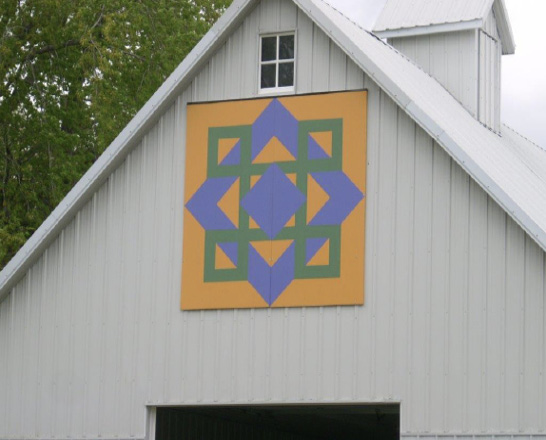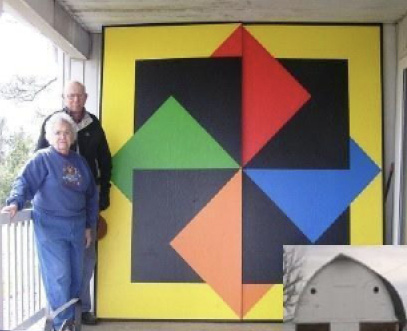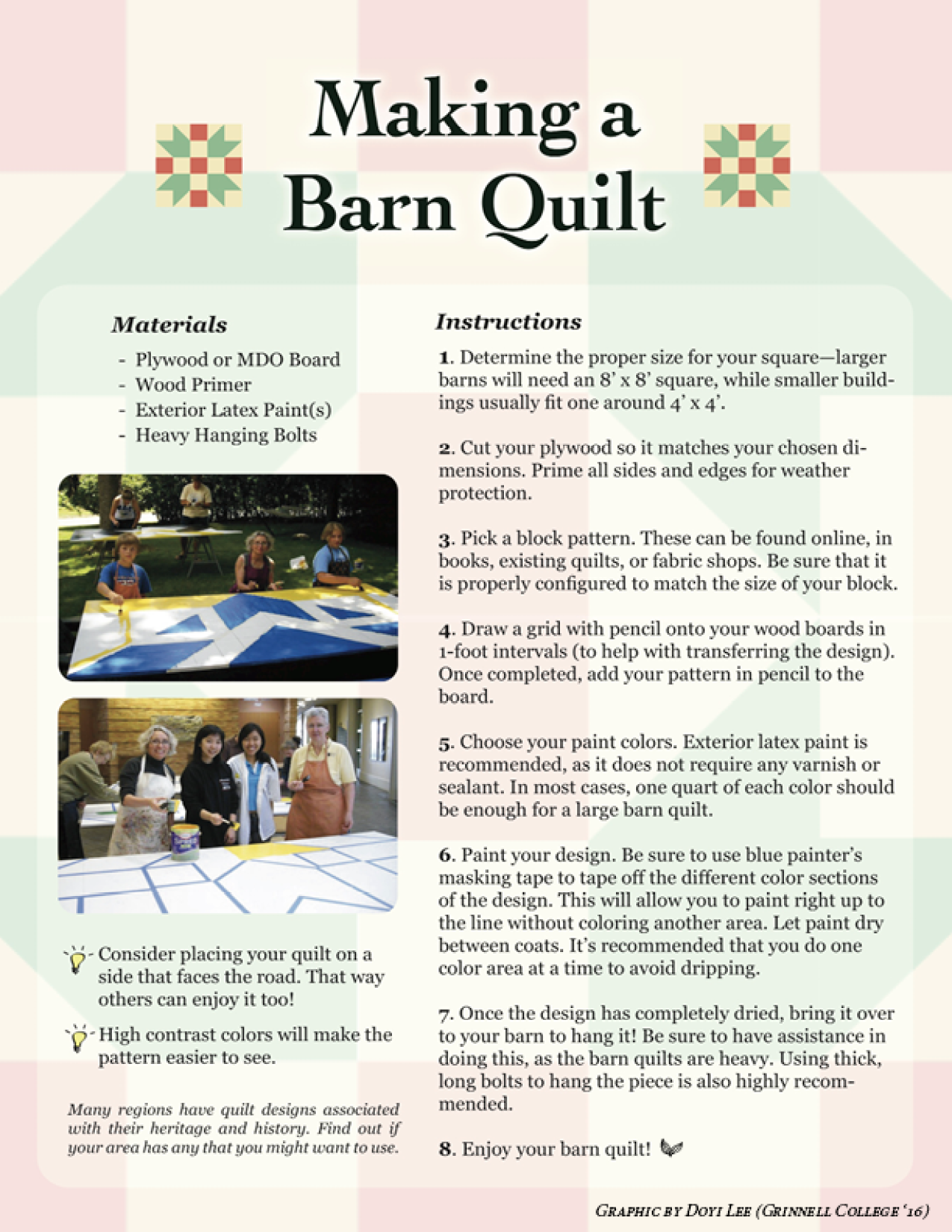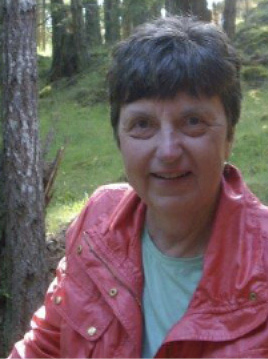In 2007, a group of like-minded women set out to make and display traditional quilt blocks in the form of large painted panels attached to barns in Poweshiek County, Iowa.
Our goal was to celebrate the beauty of two traditional icons in agricultural communities: barns and quilts. We decided we wanted to place at least one barn quilt in all sixteen townships in the county. By the time our committee disbanded—our money and energy dwindling at about the same pace—there were twenty-one pieces of public art gracing the barns of Poweshiek, thirteen of them made by us. We believe we succeeded.
Along the way, we designed and painted barn quilts, involved county 4H groups, held a county-wide quilt show, drove the backroads looking for barns, and heard snippets of farm stories that otherwise would have gone untold. We hauled huge plywood panels around to parades and various events as a means of advertising, raised money, made notecards, designed, printed and sold a calendar. We decorated a Christmas tree at the local library with handmade barn quilt ornaments, learned some county history, wrote and published a brochure, narrowly avoided at least one large public relations blooper, and finally, quietly, ran out of steam.
We were a core group of nine: Claire Moisan, Betty Moffett, Tilly Woodward, Evelyn Bunn, Marion Chamberland, Debbie VanArkel, Cathy Lents, Jane Bazyn and I. But, Lord, we had help: funders, businesses, newspaper editors, the College, the local quilt guild, county Extension, barn owners.
Why barn quilts?
In a way, they are unlikely partners. A quilt block is form and color, simple geometric shapes—usually squares, rectangles and triangles. Quilt blocks transform real life into abstractions; they embody things that their makers encountered every day— told through their names: “Lone Star,” “Flying Geese,” “The Hunter,” “Bear Paw,” “Pinwheel,” “Churn Dash,” “Broken Dish.” They also suggest half-told tales, scraps of dreams, religious imagery—“Trip Around the World,” “Wedding Ring” (ironically also known as “Crown of Thorns”), “Irish Chain,” “Drunkard’s Path.”
On the other hand, barns—those simple, unadorned places of work—lack whimsy. They house livestock and hay, cats, bats and birds, and they smell of those things. In the bleak winter landscape, ghostly gray barns break the barren skyline, noble in their austerity. Sadly, these unassuming icons are disappearing at an alarming rate, reflecting the way the agriculture has changed over the past thirty years. Old barns are expensive to restore and often aren’t suited for today’s much larger equipment and different strategies for housing livestock. In the 1930s, Iowa boasted 200,000 barns; we’re down to 50,000 with many among that remainder crumbling or being taken down every day.

“Celtic Sunrise” on the barn of Jim and Pat McIlrath, Newburg Road east of Highway 146. The barn, built in 1956, held corn when it was still picked and stored in the ear. Photo courtesy of Janet Carl.

“Spinning Pinwheel”— When Lois and Phil Evans bought their farm in 1959, according to Lois, the barn floor was “clean enough to picnic on” because of the previous owner’s loving care.” She says another of the barn’s interesting features is an indoor track around the inside. Its use? “About six feet above your head hung a manure bucket that traveled around the barn so that manure could be scraped out of the stalls and not have to be carried out by hand. It could be pulled out of the barn on this track.” Photo courtesy of Janet Carl.
Barn quilts draw our eye to barns in the way a celebrity draws a paparazzo’s eye. They offer durable beauty in out-of-the-way places. And they are beautiful, even when no one is looking. Admired by a carload of folks wandering the backroads or only by the farm family, they are still out there on the land, a benediction, like the birds, and the livestock and the straight rows of grain. That seemed as much justification as we needed to approach barn owners and ask them if we could hang a barn quilt.
We wanted to make saying “yes” as easy as possible, so we gave barn owners a choice of patterns and colors for their quilt. But we also wanted the art to reflect a bit of personal or county history as well. The eye-catching “Railroad Crossing” at the corner or Highway 63 and Old Six Highway, for example, commemorates the first train junction in Malcom Township. “Wedding Ring” celebrates the marriage in Warren township of James Manatt to Lavina Snook in 1852, as well as the marriage of the owners, Bob and Marilyn Collum. In fact, celebration become a theme: celebration of the first First Lady (“Martha Washington Star”), a Civil War ancestor (“Yankee Puzzle”) Celtic heritage (“Celtic Sunrise”), a 50th wedding anniversary (“Mountain”) the hunters in the family (“The Hunter”).
Every day I drive east on Highway 6 into Grinnell, and every day I automatically look again at the “Jewel Box” quilt hanging on a small ramshackle outbuilding at the junction with First Avenue East extension. That wooden barn, built in the early 1902, was used for horses, milk cows and grain and buggy storage. The paint has worn off, the building is listing a bit, and the roof shingles are curling at the edges, but the block is as fresh and colorful as ever—it’s the one block we did that utilizes eight different jewel tone colors. The block and the barn are obviously, but happily, incongruous. It’s like bedecking a rundown old workhorse with the queen’s jewels. It seems to me that both are better for it.

“God’s Eye” in Madison Township. The building which features this barn quilt was built 130 years ago and features square pegs and native stone. The original owners raised purebred stallions, and sales attracted buyers from many states. Local firefighters practiced getting enough pressure to shoot a stream over the top of the building. The block celebrates the importance of the Madison Church of Christ in the life of the community. Photo courtesy of Janet Carl.



